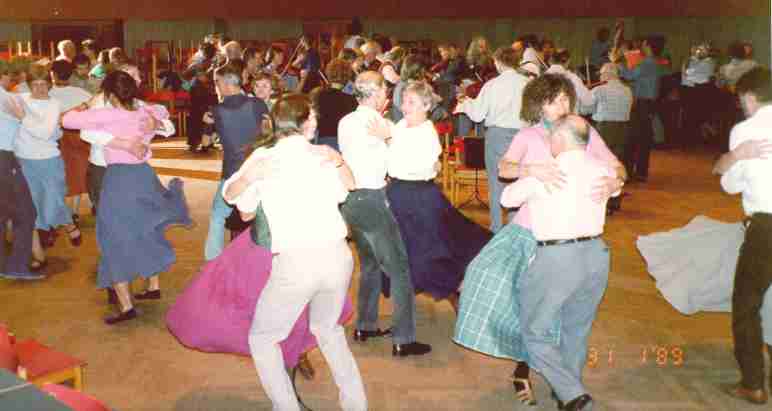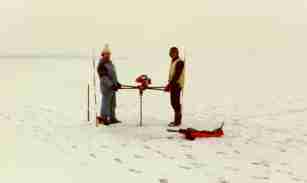
Når vandet fryser (Freezing Waters) |
| Niels Mejlhede Jensen, Bøgeløvsvej 4, 2830 Virum, Denmark. e-mail (web master) |
CONTENTS: (remember: you can use Ctrl Home in usual browsers to get to the top of this page, to the links here)

Photo 1 of this week: A tuesday evening dance with Spillemandsdansen (Fiddlers' dance) at the Technical University. Musicians are in the middle of the ballroom, in the middle of the dance. We here have the chain in a 3 corner dance: when you meet your partner in the chain you give your partner a left arm hook and turn around your partner and walk the opposite way back home with a normal hand chain.

Photo 2 of this week: after the chain phrase in the 3 corner dance, there are couple wise two steps (= pivot) in the small circle of 3 couples.
 Photo 3: Benefit of frozen waters now a days: together with a colleague
I am here performing a geotechnical investigation of the soil of the sea
bottom off the coast of Denmark, by drilling into the soil from the ice
covering the sea. So the winter with frozen water can also be useful now
a days, to make this engineering work much easier and more economical.
Photo 3: Benefit of frozen waters now a days: together with a colleague
I am here performing a geotechnical investigation of the soil of the sea
bottom off the coast of Denmark, by drilling into the soil from the ice
covering the sea. So the winter with frozen water can also be useful now
a days, to make this engineering work much easier and more economical.
Dance of the week, 1999, April 12:
The melody can be heard in midi on computer piano in my tempo (if you
have a sound card). (The melody will loop here until you stop it. In the
table below it will play once). (I have not played the tunes here with
the "drive" I want for dance music).
| 1 | melody | the traditional good dancing melody, polished through generations of use on the fiddle | |
| . | chord
text |
Midi metronome:
dotted crotchet = 90 crotchet = 135 |
simple (folk music) chords, natural for playing the accordion;
these chords are used to make the other parts or voices in triad harmony; there should be no tension from dissonance anywhere including in octave |
| 2 | A | (Above), parallel part nearest above in third or little more above | |
| 3 | B | (Below), parallel part nearest below in third or little more below | |
| 4 | ns | simple n part; often with the tonic feeling and often with the basic dance rhythm ("motor part") | |
| 5 | C1 | C parts are made from A and B parts, and so they are two parts to the melody | |
| 6 | C2 | C2 is less simple than C1 | |
| 7 | mod =
contra part |
voice up and down (mostly) contra to the melody; it is also made from A and B | |
| 8 | n1 | n is a less constricted part, and tones from the melody are freely included | |
| 9 | C1 | octave down | |
| 10 | n1 | octave up | |
| 11 | B | octave up | |
| 12 | blank | . | blank staff for making your own part according to the principles here |
(The midi music is not repeated, except for 1' and 2' voltas).
Use also octave, up and down.
Where wanted, notes can be changed according to the principles (use
a colour pencil), e.g. to improve the B part with some notes from
A.
The music is aimed at dancing, so part of the orchestra can be the
underlying "motor" when another instrument group is playing its "solo"
part (improvisation) as one of the many repetitions.
The double bass may play its usual notes, because of its low pitch.
It is better to choose a more simple part and play it well.
Accordion: beats per bar: 2+2 on beat 1, 3, 4, 6, where
3 and 6 are light chord beats, (to "lift" you over to the immediate following
marked beat on the single bass).
(It is not a song with only 1+1 beats per bar, and it is not
a waltz with 2 x (1+2) beats per bar).
I find it very OK with 2 beats per bar (for two steps and walking steps)
with 2 almost alike beats.
(Help coming back from that note
sheet: CLICK the note sheet to come back to this page, or just close
the note window.
Remember: the note sheet opens in a new separate window, and that may
cover the whole screen. The back button in the tools bar does probably
not work because the window is new, with no history. All you see on the
page are notes because I have placed no link back here for not disturbing
easy submitting to the printer. Close the note window with a click at the
top or with Alt F4, or minimize or reduce the window, or ..., and you are
back to the main page that was there behind all the time).